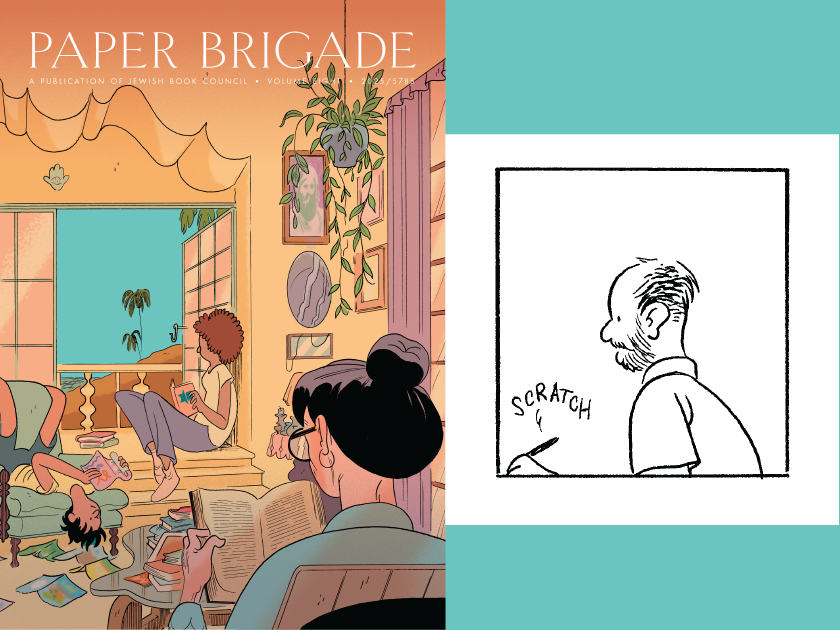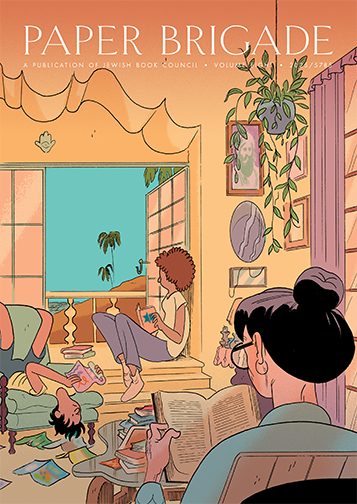
Self-portrait by Sammy Harkham
This piece originally appeared in a JBC email on Friday, August 29. Sign up here for our emails to be one of the first to know the latest Jewish literary news!
Becca Kantor: I first became aware of your work when your brilliant graphic novel Blood of the Virgin came out last year. What are some continuities between that book and the cover you created for the 2025 issue of Paper Brigade? (The LA setting is one of the first things that comes to my mind … )
Sammy Harkham: I definitely have my lifelong preoccupations, so there are likely connections between all my projects. Both Blood of the Virgin and the Paper Brigade cover reflect an endless fascination with the dynamics of Los Angeles. Visually, it can be a worn-down city, with its best days behind it. There’s bittersweet beauty in something irretrievably lost. In my novel, that theme is conveyed through setting, laying the groundwork for all kinds of ideas and plots: Hollywood in the seventies, marital discontent, all kinds of sex jokes, displaced Jews, the tyranny of time, ambition, and parenthood. The setting of Los Angeles (at least how I envision it) glued all those ideas together. On top of that, culturally, Los Angeles is an immigrant city where cultures don’t necessarily blend but can thrive distinctly. It is, in many ways, more a Mexican city than an American one. It is intensely and beautifully diverse. The cover reflects Sephardic and Ashkenazi strands of Judaism, as does Blood of the Virgin, as does this city and my own family.
BK: Could you tell me a bit about your creative process?
SH: I sketch looking for images that trigger something. The initial drawing is always a doorway that hopefully leads to a breadcrumb trail of more ideas. I don’t try to understand these ideas; I trust my subconscious to get the thing where it wants to go. I find that once the piece is done and some time has passed, I can see clearly what my subconscious mind was doing, down to each individual element.
BK: I’m struck by the way you embedded small cues into the cover illustration — the hamsa; the portrait of the Ben Ish Chai, a venerated scholar, Kabbalist, and chief rabbi of Baghdad — to indicate that the interior we see is a Jewish home. How did you come up with these details?
SH: The cover prompt was “books and reading,” and that makes me think of Shabbat in the afternoon, which makes me think of being present and at peace. But inherent in that idea is an end to peace, since Shabbat inevitably comes to a close at sundown. Hence the horizon line: it’s a consideration of what unknown forces may be coming. The architecture reflects Spanish Revival design, suggesting that cultures faded from the region once Mexico and America acquired California in the 1800s. The picture of the Ben Ish Chai connects that concept to Baghdad, another place of displacement. A place where one in four people were Jews and that had served as a center of Jewish life since the destruction of the beit hamikdash. Yet Baghdad’s Jews — my father among them — were persecuted and turned into refugees in practically an instant. A thousand years of Babylonian Jewish culture, over in the blink of an eye. What feels permanent, then, is an illusion. Maybe the Shabbat peace of the last eighty years in America is over, and something new is on the way. So the hamsa is a nod to the idea that regardless of what we perceive as “good” or “bad” in our daily fortunes, at the end of the day, we live in God’s hands.
BK: Lastly, could you name a Jewish book that inspired you? How did it influence your work?
SH: Hard to pick one, but for now I will say The Magic Barrel by Bernard Malamud. Besides being pure dessert in the form of stories, it is a solid reminder that you can write from a truly idiosyncratic place. Readers will engage with the work very deeply because of the extra effort you put in to wrestle with cultures and values they may be unfamiliar with.
This piece originally appeared in a JBC email on Friday, August 29. Sign up here for our emails to be one of the first to know the latest Jewish literary news!
Becca Kantor is the editorial director of Jewish Book Council and its annual print literary journal, Paper Brigade. She received a BA in English from the University of Pennsylvania and an MA in creative writing from the University of East Anglia. Becca was awarded a Fulbright fellowship to spend a year in Estonia writing and studying the country’s Jewish history. She lives in Brooklyn.
